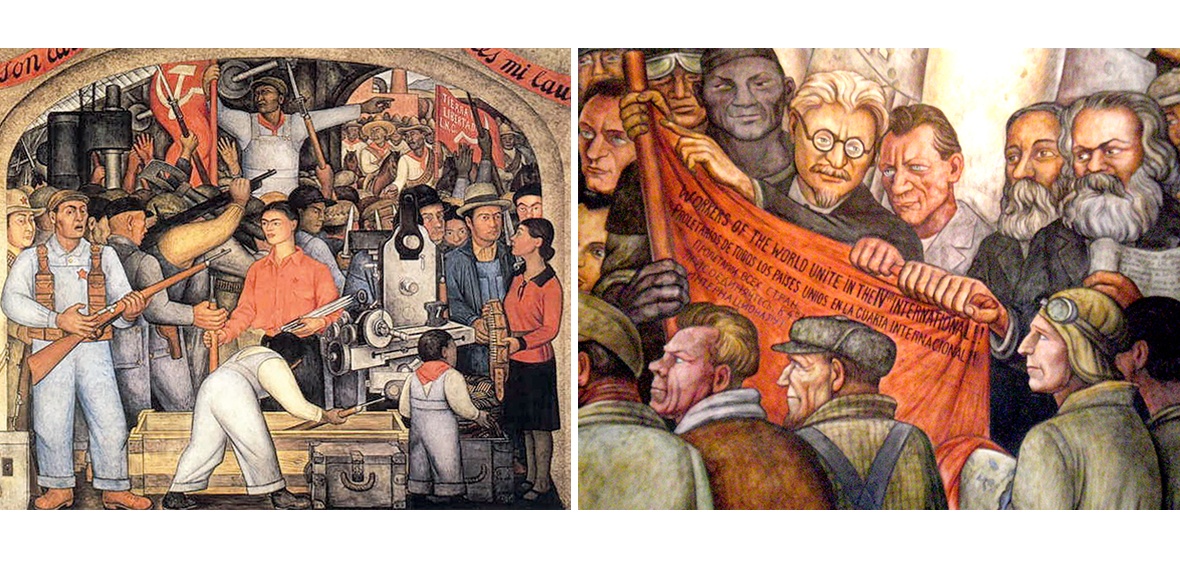This is the last article you can read this month
You can read more article this month
You can read more articles this month
Sorry your limit is up for this month
Reset on:
Please help support the Morning Star by subscribing here
DIEGO RIVERA is back in town again. No, not in person. He died in 1957 in Mexico City at the age of 70, but his art is in San Francisco, where he painted murals in 1930 at the Stock Exchange, and again in 1940 at the Golden Gate International Exposition.
Rivera’s art is at the San Francisco Museum of Modern Art (SFMoma), and, while it’s well worth viewing, the official comments by the museum can be obtuse.
Maybe look at the art, decide for yourself what you see, think and feel about it, and don’t take Moma’s interpretations as the final word.
Those interpretations, unlike the art, are unsigned. Whoever wrote them didn’t know how to talk intelligently about Rivera’s radical politics and his radical way of looking at the world and representing it in murals and paintings.
The museum allows that Rivera was a communist. It doesn’t hide that fact, as other museums have done in the past, though it also aims to sanitise Rivera, made him less revolutionary than he was in person and on walls and canvases and also rebuke him for what the museum staff perceives as his sexism in a painting that depicts women bathing and washing clothes in the Tehuantepec River.
The nude figures have breasts. “Today,” the text that accompanies the painting reads: “We should be more critical of Rivera’s eroticisation of these indigenous figures, part of a broader cultural tradition in which women from so-called exotic locales — Andalusia, Algeria — were objectified by white European artists, writers and intellectuals, almost invariably men.”
The museum seems to be aiming to cover its own ass and not open itself to rebuke from critics who might lambast the inclusion of the nude females.
Yes, Rivera was a man, but he was Mexican, not a white European. He regarded the indigenous inhabitants of Mexico as sexual beings, but it’s possible to see and realise that he didn’t eroticise them or turn them into exotic figures.
The museum doesn’t take him to task for a painting that depicts two women making tortillas, though it might have slammed him for connecting tortilla making exclusively to women.
In Mexico, as elsewhere, some jobs and tasks were linked to women, others to men. That’s the way the gender cookie crumbles.
The museum also explains that some of Rivera’s work was not “overly anti-capitalist” as paranoid North Americans feared it would be. But look closely and you’ll likely see that Rivera tended to render workers with empathy, but not capitalists or members of the bourgeoisie.
True, he painted a portrait of Edsel Ford, Henry Ford’s son, but in his jacket, white shirt and blue tie, his body rather stiff and hard, Edsel seems more machine-like than human.
In Pan American Unity Rivera’s “America” includes both hemispheres, North and South, and implicitly rejects the notion that the US and no other part of the “New World” was the real and the true America.
For Rivera, as his art shows, workers created society’s wealth. They provided the foundation on which everything else was built. In that sense, his work is Marxist and perhaps even explicitly communist.
In 1933 in New York, Rivera painted two small frescoes for the Communist League of America, a Trotskyist organisation, that depicts both Lenin, in the background, and Trotsky in the foreground.
Rivera also memorialised the hammer and the sickle in his art, and let’s not forget that in 1934 the Rockefellers destroyed the mural they had commissioned in 1932 and that was slated for Rockefeller Centre in New York.
Who says the Russians under Stalin were the only ones to censor politically charged art?
I grew up in a lefty family and was introduced to Rivera’s work as a boy. When I lived in Mexico City in 1975 I went everywhere looking for his murals, and, years later when I visited friends in Guanajuato City, where Rivera was born in 1886, I saw the small museum which honours him and his work.
The SF Moma exhibit reveals that Rivera was technically brilliant, and that he mastered his craft as well as Michaelangelo mastered his during the Italian Renaissance.
The exhibit includes Rivera’s portraits along with his murals and makes a convincing case that his smaller canvases were as expertly done as his big works.
His portrait of his second wife, Guadalupe “Lupe” Marin, who preceded Frida Kahlo, is a masterpiece. You can’t look at it and not sense how deeply Rivera felt about her.
Perhaps my favourite piece in the SF Moma show is The Flower Carrier from 1935 that depicts a small Mexican man on his hands and knees, with a huge basket of flowers on his back while a woman larger than him aims to balance the weight.
Another piece shows a barefooted woman carrying an immense load. You can feel her and hear her groaning.
Clearly, Rivera loved Mexican workers and peasants, as well as the workers and peasants of all the Americas.
Bravo, SF Moma for mounting an exhibit that runs until January 2 2023.
Jonah Raskin is the author of Beat Blues, San Francisco, 1955.











